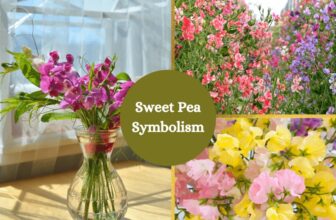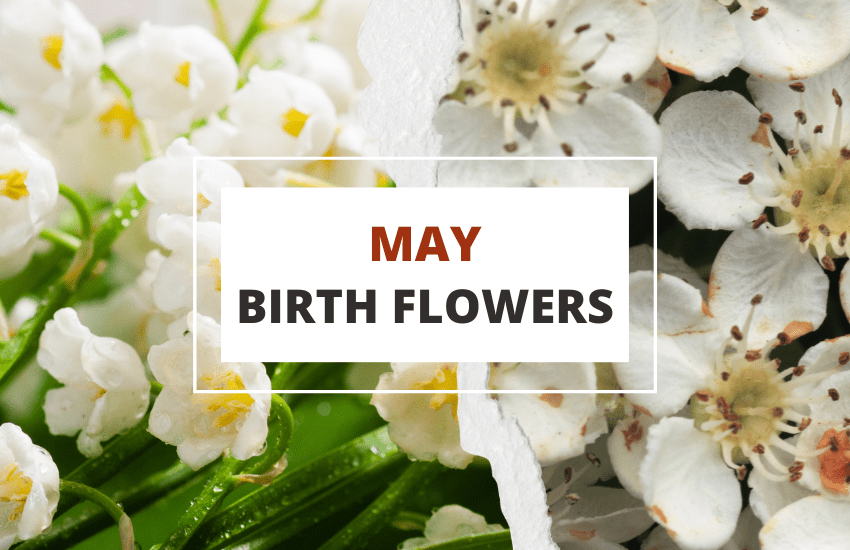
Table of Contents
The birth flowers of the month of May are the Lily of the Valley and Hawthorn. Both these flowers are delicate blooms that are found mostly in white and represent purity, care, sweetness, and sincerity.
Therefore, it’s no wonder that people born in May tend to be sweet, grounded, giving, and practical, just like the flowers that represent their birth month. Both these May birth flowers are rich in history and symbolism and have also been mentioned in numerous legends.
In this article, we’ll take a closer look at these two beautiful birth flowers as well as the uses, meaning, and symbolism behind them.
Lily of the Valley – What You Need to Know
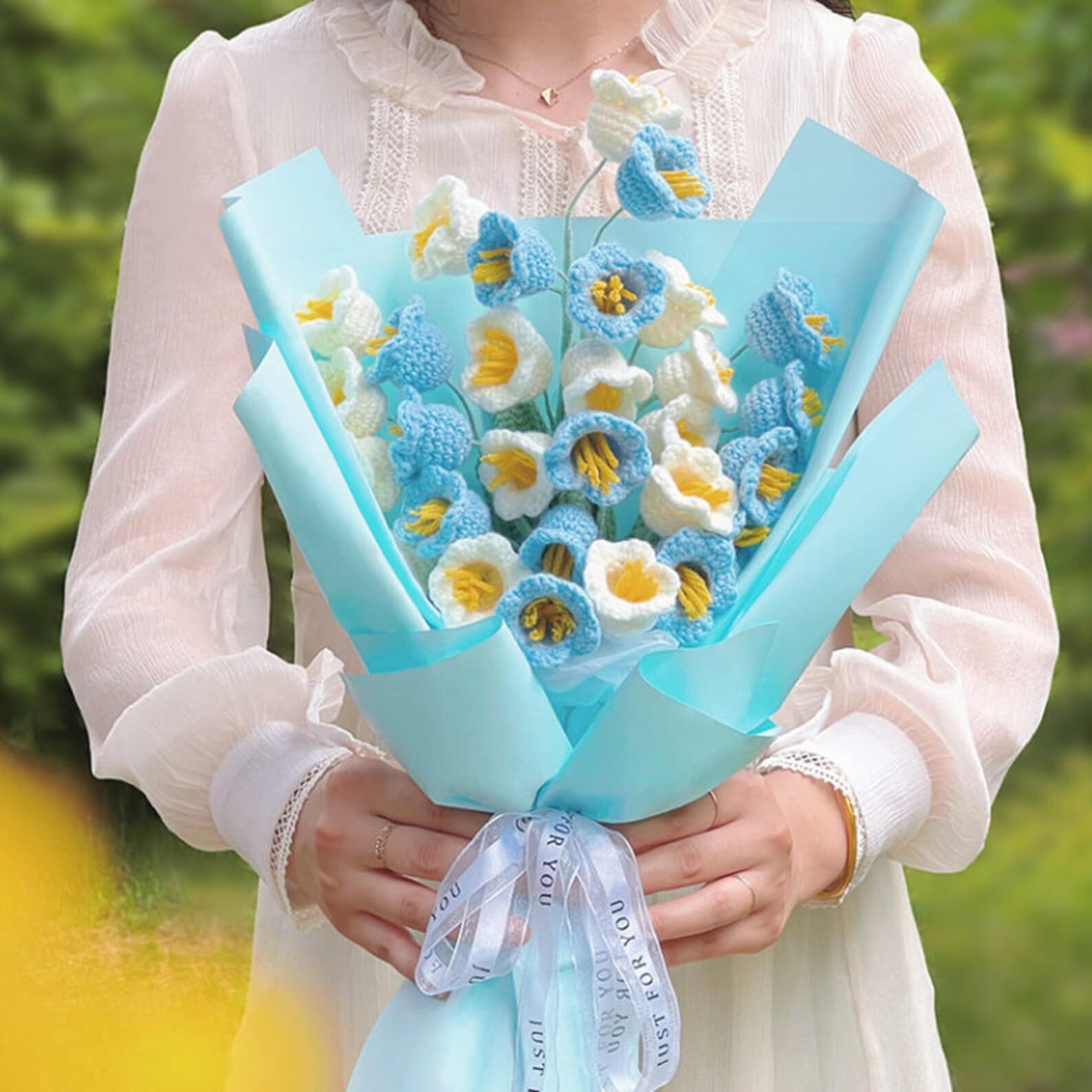
Lily of the Valley (Convallaria majalis) is a small, perennial flowering plant native to Europe and Asia. It’s known for its sweetly fragrant, bell-shaped white flowers that bloom in the spring. The plant has narrow, dark green leaves and prefers moist, shady environments.
Interestingly, the flowers emerge in clusters from only one side of a long stalk, leaving two glossy leaves at the bottom of the stem. In addition, although May bells are majorly white, sometimes they blossom in purple or pink. In folklore, Lily of the Valley is associated with happiness and is often given as a symbol of love and good luck.
It’s not surprising that these flowers bloom in May considering that all their names point to the month. Firstly, the name May bells indicates their shape and the month they appear. Secondly, their botanical name is Convallaria majalis, with the term Convallaria translating to “Valley plant” and the word majalis, “of May”.
Lily of the Valley Facts
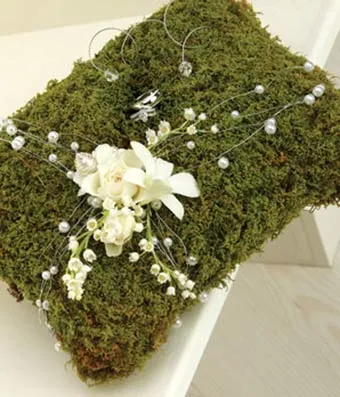
- Lily of the Valley is the centerpiece of the age-old, annual Furry Dance in Helston, England. The dance, which takes place on May 8th, is a festive way of marking the end of winter and the beginning of spring.
- May bells were revered in both Greek and Roman mythology, with both purporting that the blooms were under the protection of the goddess Maia’s son. The name of the son varies according to culture; the Greeks called him Hermes while the Romans referred to him as Mercury.
- Lily of the Valley is a poisonous plant, containing toxins that can cause vomiting, diarrhea, and other symptoms if ingested.
- The plant is a popular choice for wedding bouquets and is often used in perfume due to its sweet fragrance.
- Lily of the Valley is native to Europe and Asia and can be found in wooded areas, forests, and along streams.
- The plant has a long history of medicinal use, with the roots and leaves being used to treat various ailments including heart disease, epilepsy, and diabetes.
- Lily of the Valley is a popular houseplant and is easy to grow in a shady spot with moist soil.
- The plant is a symbol of humility and sweetness in Christianity and is mentioned in the Bible as a symbol of Christ’s second coming.
- In medieval times, the Lily of the Valley was believed to have magical properties and was used to ward off evil spirits and to bring good luck.
Lily of the Valley Meaning and Symbolism

Lily of the Valley has a variety of meanings and symbolism associated with it. Here are a few:
- Romance – The Lily of the Valley is widely used as a representation of romance, especially because of its fragrance. For example, during La Fête du Muguet, a French festival, men present them to their lady loves to show their affection.
- Happiness – Because they bloom during spring, a time of warmth and joy, May bells have become a depiction of happiness. You may gift them to someone to give them hope that they will be happy again.
- Purity – With their white petals, which are arguably some of the whitest in the flower kingdom, lilies of the Valley stand for purity.
- Motherhood – This significance is borrowed from two Christian lore, one being the association with Eve’s tears and the other the belief that they represent the Virgin Mary’s purity.
- Sweetness – With their pure color and sweet fragrance, May bells have become a representation of sweetness. They are therefore presented to people believed to be sweet and pure of hearts.
- Good luck – The Lily of the Valley is believed by several cultures to bring good luck. Examples of these cultures are Holland where they are planted by newlyweds to bring luck to their marriage, France where they are gifted as a wish for luck, and Serbia where they are used for decoration during St. Georges feast day to bring prosperity and good luck. This significance is perhaps the reason Lilies of the Valley are common in wedding decorations.
- Serenity– This significance is tied to the belief that the bell-like shape of Lilies wards off evil spirits. They are, therefore, planted near the house to provide peace of mind.
- Sadness – Even with all the positive symbolism, the Lily of the Valley sometimes is used to signify pain and sadness caused by loss. This is the reason they are common at funerals. However, when used in these circumstances, they still spark positivity as they bring with them hope for better days and a return of happiness.
Growing Lily of The Valley
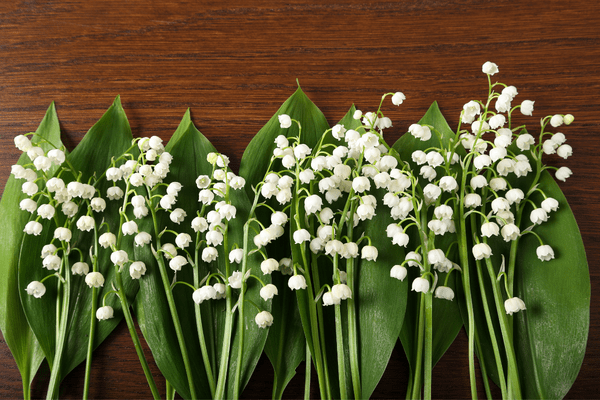
If you’re interested in growing Lily of the Valley, there are some things you’ll need to take into consideration. Here are the key growth requirements:
- Location: Lily of the Valley prefers a shady spot with moist, well-draining soil. It is a good choice for a wooded area or along the edge of a stream.
- Soil: The plant prefers moist, well-draining soil that is rich in organic matter. Avoid planting it in dry, sandy soil.
- Water: Lily of the Valley requires consistently moist soil, so be sure to water it regularly, especially during dry spells.
- Fertilization: The plant does not require a lot of fertilization. A light application of a balanced fertilizer in the spring is sufficient.
- Temperature: Lily of the Valley is hardy in USDA zones 2-9 and can tolerate a wide range of temperatures. It is best to plant it in the spring or fall when the temperatures are cool.
- Sunlight: The plant prefers partial shade and should be protected from direct sunlight, especially during the hottest hours of the day.
Hawthorn- What You Need to Know

Hawthorn (Crataegus) is a large genus of shrubs and trees native to the temperate regions of the Northern Hemisphere. These plants are known for their clusters of white or pink flowers that bloom in the spring, as well as their small, red, or orange berries that are popular with birds.
The leaves of hawthorn plants are typically bright green and have a serrated edge. Many species of hawthorn are used in traditional medicine for their cardiovascular benefits.
In addition to their medicinal and ornamental value, hawthorn plants are also popular for their ability to provide habitat and food for wildlife. They’re often used in landscaping for hedges, screens, and borders.
Hawthorn Facts
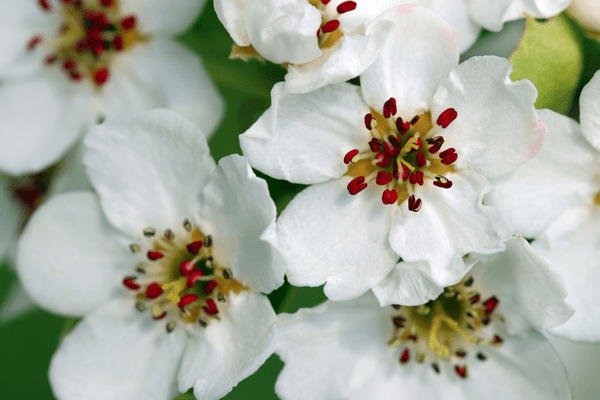
- Hawthorns are edible, with their young leaves being used in salads and their berries to make wine, jelly, or simply eaten as they are.
- Since ancient times, Hawthorns have been used to treat chest pains, blood disorders, and heart disorders. Moreover, modern medicine has proven that the antioxidants found in the plant are effective in reducing cholesterol levels as well as high blood pressure.
- The hawthorn shrub was revered as a sacred plant in Celtic mythology. It was believed that fairies lived in it as guardians. As a result, plucking hawthorn blooms was outlawed allowing only the collection of fallen flowers.
- In ancient Serbia, popular lore stated that vampires would be slayed by the use of stakes made of hawthorn.
- There are over 1,000 species of hawthorn plants, which are native to the temperate regions of the Northern Hemisphere.
- Hawthorns are known for their clusters of white or pink flowers that bloom in the spring, as well as their small, red, or orange berries that are popular with birds.
- The wood of hawthorn trees is hard and dense and has been used for a variety of purposes including tool handles, firewood, and furniture.
- In folklore, hawthorn is associated with fertility and is sometimes used in wedding ceremonies to symbolize love and fertility.
- The hawthorn plant is the national flower of England and is featured on the English coat of arms.
- Hawthorn plants have long lifespans and can live for hundreds of years.
Hawthorn Meaning and Symbolism

The hawthorn plant has a variety of meanings and symbolism associated with it. Here are a few:
- Change – Hawthorns became symbolic of change because they mark the end of spring and the beginning of summer.
- Gateway – With the belief that fairies lived in Hawthorns, the plants came to be thought of as the gateway to other worlds.
- Healing – In Celtic lore, these blooms were belied to cure broken hearts.
- Fertility – Pagans associated Hawthorns with fertility, so much so that they became the symbol of it. In folklore, hawthorn is also associated with fertility and is sometimes used in wedding ceremonies to symbolize love and fertility.
- Motherhood – Generally, Hawthorns are thought to represent motherly love and care.
- Protection: Hawthorn plants are believed to have protective powers and are sometimes used to ward off evil spirits and to bring good luck.
- Love: The plant is associated with love and is often given as a symbol of love and commitment.
- Renewal: The spring blooming period of the hawthorn is associated with renewal and the start of a new season, making it a symbol of hope and new beginnings.
- Medicine: Many species of hawthorn are used in traditional medicine for their cardiovascular benefits, and the plant is sometimes seen as a symbol of healing and restoration.
- English pride: Hawthorn is the national flower of England and is featured on the English coat of arms, making it a symbol of English pride and heritage.
Growing Hawthorn
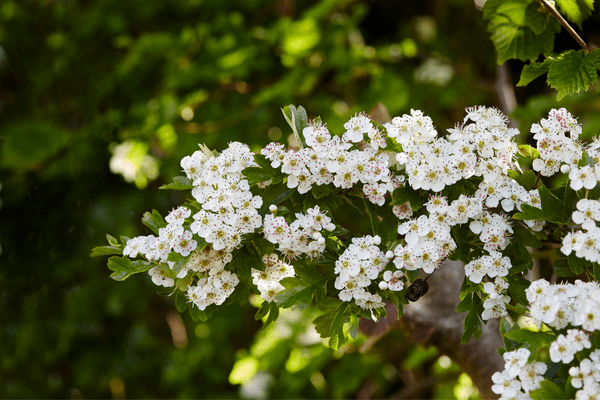
Hawthorn flowers can be grown in a variety of soil types, but they prefer well-draining soil that is slightly acidic. They prefer full sun but can also tolerate partial shade. It’s important to water hawthorn flowers regularly, especially during dry periods. They can be prone to pests and diseases, so it is important to regularly check for and address any problems that may arise.
Pruning is also important to maintain the shape and size of the plant. With proper care, hawthorn flowers can provide a beautiful and fragrant addition to any garden.
Birth Flower Gift Ideas for Those Born in May
If you’re looking for the ideal gift for a May born, here are a few options you could look into:
1. Lily of the Valley Pendant
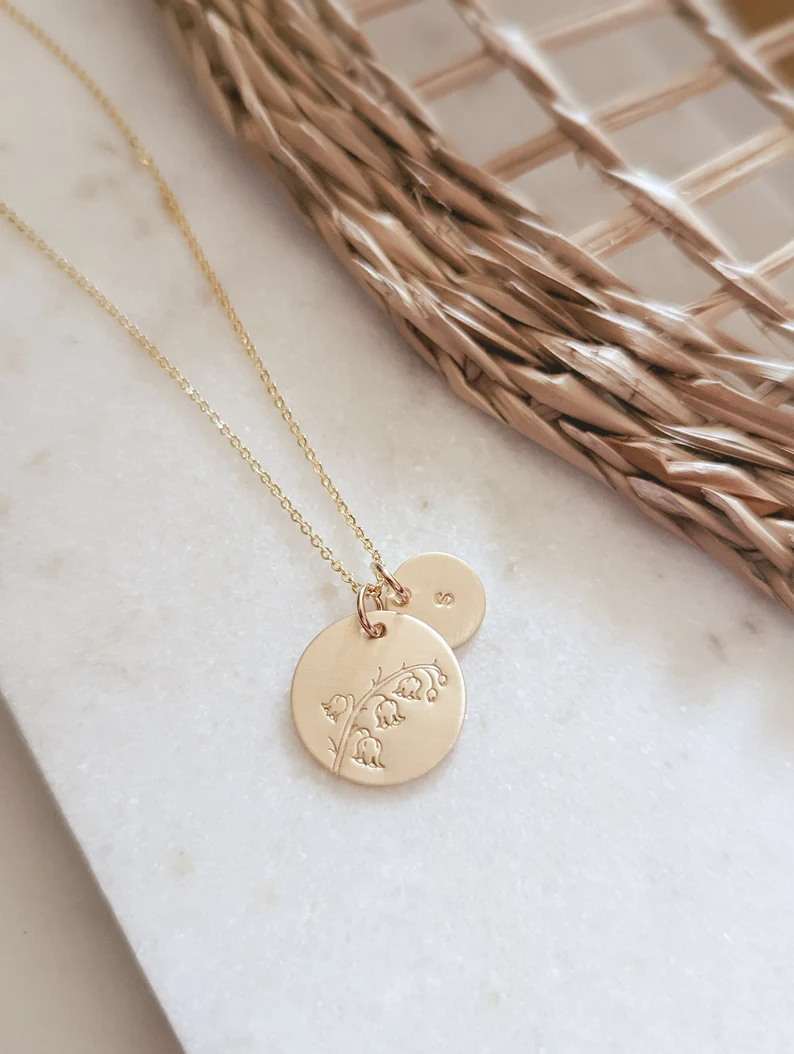
With its small white flowers, the Lily of the Valley makes for a beautiful and dainty pendant for a May baby. This gift will be ideal as it shows how much the receiver means to you and you can always have it personalized with their name and any other special details on it.
2. Lily of the Valley Earrings
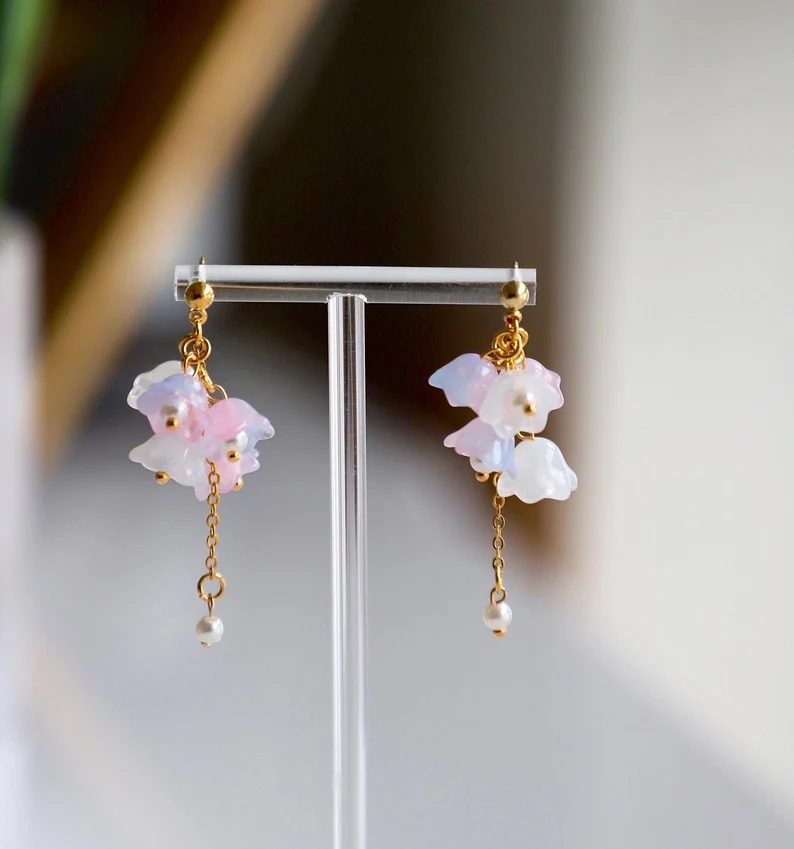
Birth flower earrings can be a meaningful and thoughtful gift for someone who enjoys nature and personal symbolism. Giving someone birth flower earrings as a gift can be a way to celebrate their birthday or to acknowledge the unique qualities and characteristics that are associated with their birth month.
It can be a meaningful and personal touch to any gift-giving occasion, whether it be a birthday, anniversary, or holiday. Birth flower earrings can also make a great conversation starter, as the recipient may not be aware of the symbolism associated with their birth flower.
3. Lily of the Valley Crotchet Flower Lamp
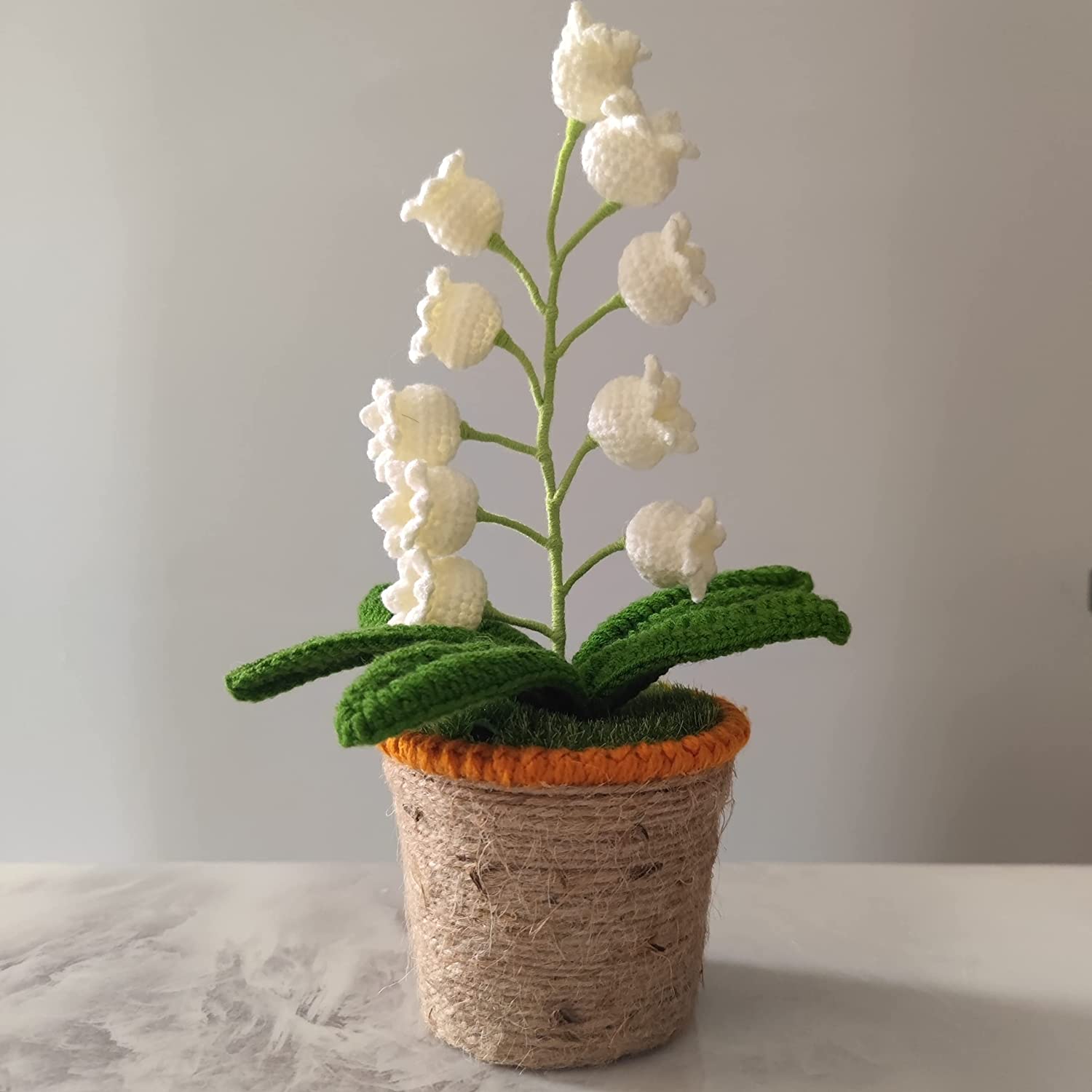
This exquisite lamp has a bulb in every crocheted flower bringing out the indisputable beauty of the May bells. The entire design is handmade using high-quality cordonnet, giving it a unique and elegant look. It can be used as a bedside decoration, crib decoration, or desk décor and it also is given as a gift for any occasion.
4. Hawthorn Scented Candles

Candles are a popular gift item that can be enjoyed by people of all ages. They can add a warm, inviting ambiance to any space and can be used to relax, unwind, and create a sense of calm.
Birth flower-scented candles can be a particularly meaningful and thoughtful gift because they are personalized to the recipient’s birth month. It can be a special way to celebrate their birthday or to acknowledge the unique qualities and characteristics that are associated with their birth month. It’s also an ideal gift for someone who values personalization and symbolism, and who enjoys scented candles.
5. Hawthorn Touchwood

Hawthorn touchwood is a type of traditional British fire starter that is made from the wood of the hawthorn tree. It is a dry, dense wood that is resistant to rot and can be easily ignited, making it useful for starting fires in outdoor or emergency situations.
Handcrafted with love, this touchwood is believed to bring hope and good luck to the wearer. Besides, it also makes for a gorgeous necklace and a unique gift for a May baby.
May Birth Flowers FAQs
Hawthorn is a powerful herb that can cause sedation and low blood pressure if ingested in large amounts. It should not be taken by children or pregnant or breastfeeding women.
This flower is used to make various medications to treat cardiomyopathy.
No, hawthorn berries are not poisonous, but they do contain amygdalin. This chemical can cause cyanide toxicity when ingested in high doses.
Yes, Lily of the Valley is mostly used in the form of tincture, extract, infusion, and tea.
Yes, hawthorn contains the vitamins A, C, and E and it can also boost the immune system.
Wrapping Up
As mentioned earlier, both birth flowers, Lily of the Valley and Hawthorn represent the beauty and hope that comes with spring. They also symbolize happiness, the return of happiness, strength, and protection. Used for various purposes around the world, both plants have been associated with a variety of meanings and symbolism in different cultures and contexts.





